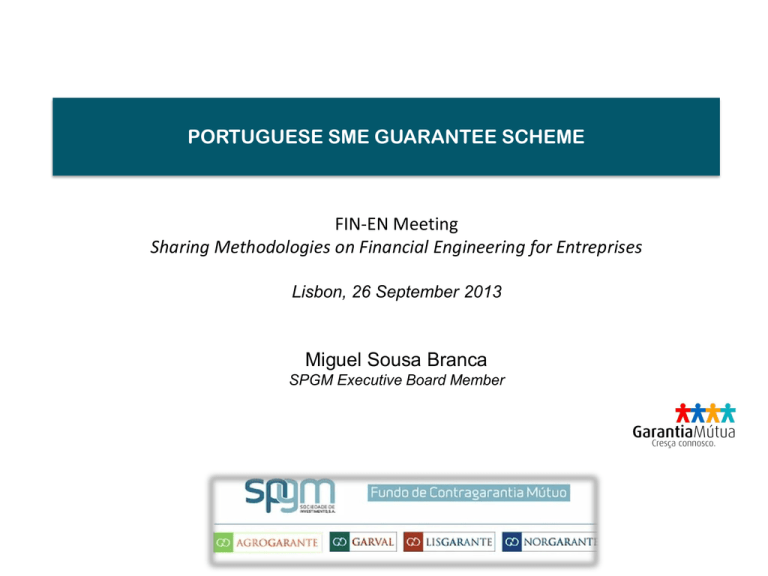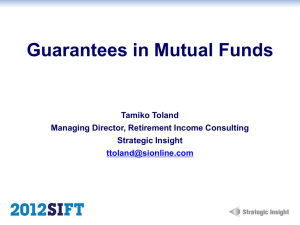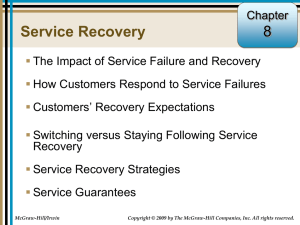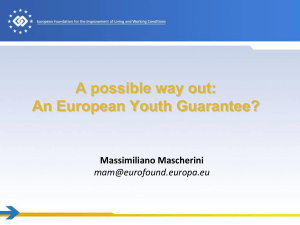of the Portuguese Guarantee Scheme.
advertisement

PORTUGUESE SME GUARANTEE SCHEME FIN-EN Meeting Sharing Methodologies on Financial Engineering for Entreprises Lisbon, 26 September 2013 Miguel Sousa Branca SPGM Executive Board Member Savings SME FILL THE MARKET GAP ON SME DEBT FINANCING … thus strengthening the market mechanisms… 2 IN ALL PHASES OF THE LIFE CYCLE OF SMEs Business Angels Venture Capital Maturity M&A Venture Capital Private Equity 3 REASONS FOR GUARANTEES TO EXIST SME are key actors in the EU economy (worldwide) They represent an important part of employment, gross domestic product and other macroeconomic indicators (such as exports). Credit finance is important to SME in the EU, as they Have limited access to venture capital, mezzanine capital, bond issues, etc. Have weak own funds positions => limited capability to self-finance fixed assets investment or working capital needs Rely predominantly on loan finance Usually have a relative lack of bankable collateral • Due to the relative lack of collateral, loan finance is more difficult to obtain than for larger companies 4 BUT WHY GUARANTEES? Due to difficulties from the conventional financial system to solve the problem of failure in the credit markets, which do not get adequate funding to businesses, particularly to micro and SMEs or corporations on the early stages of their life cycle, alternative banking coverage risk mechanisms have been created; Among these mechanisms, one should highlight the credit guarantee scheme for SMEs, based on specialised institutions in covering (usually partially) bank credits to SMEs; In most cases these schemes put together private and public entities and respective funding; The Portuguese Mutual Guarantee Scheme consists of a public and private partnership: mutual guarantee societies which get a public counter guarantee from a public Fund. This Guarantee Scheme facilitates access to finance by providing credit default guarantees for SME that Are economically reliable But do not count on sufficient collateral to access bank credit ADDED VALUE OF GUARANTEE SCHEMES Advantages to SME Access to finance for economically reliable projects Recognition of qualitative factors in credit guarantee entities/ MGS risk analysis Not highly profit oriented Intermediary function of Scheme towards lender Participation in management of scheme 6 ADDED VALUE OF GUARANTEE SCHEMES Advantages to banks Reduction of bank’s risk exposure, improvement of credit quality Build-up of SME-Retail portfolio Financial supervision of MGS => Trust and sustainability vis-a-vis lending partners MGS provides specific sector knowledge of SME customer in addition to traditional analysis Specialisation in guarantee business Mitigation effect on risk-asset ratio, thus reduction on capital consumption by the banks High level of liquidity of guarantee vis-a-vis other types of collateral (usually guarantees are first demand) 7 ADDED VALUE OF GUARANTEE SCHEMES Advantages to Public authorities Individual risk assessment and follow-up Financial intermediary for public policies Counterguarantee element (regional, national, EIF-CIP) Cost effective leverage effect of MGS’ regulatory own funds But above all there is an important financial leverage of public funds 8 PORTUGUESE GUARANTEE SCHEME MODEL 9 MAIN FEATURES OF THE PORTUGUESE GUARANTEE SCHEME Mutual Guarantee Societies (MGS) issue the guarantees. The MGS share capital is held majority by beneficiary SME (>50%), banks, SME organisations and SPGM. Thus, they are mutual and private credit institutions; Their scope is to support the access to finance of micro and SMEs [MGS also support University students and self-employed professionals]; MGS provide on first demand financial guarantees aimed to help SMEs accessing credit in adequate price and term conditions; The MGS get a partial counter guarantee from the national Counter Guarantee Fund (FCGM). They assume their own risk analysis activities and credit decisions. The price of the guarantees is set according the risk appraisal results (internal rating model), inside the global boundaries defined at MGS board level (currently minimum fee of 0,5% and maximum of 4,5%, per annum on the outstanding amounts); They are subject to internal and external auditors; They are supervised by the central bank and act under a specific regulation as well as under the general banking laws (including Basel II and III). 10 BASIC FEATURES OF THE PORTUGUESE GUARANTEE SCHEME The Counterguarantee Fund (FCGM) automatically covers a part of the risk assumed by MGS. It has no direct contact with either SME and Banks; Its own funds are fully owned by the Government; Is doesn’t carry any kind of risk analysis on individual files as counterguarantees are by law automatic and compulsory; The counterguarantee levels goes from 50% to 80% of the guarantees issued by the MGS, depending on the type of product; The Fund is managed by SPGM; The Fund is audited by internal auditors, being the external one the Auditor Body of the Central Bank. It is submitted to specific auditing from tax authorities and Court of Auditors, namely in specific programmes supported by EU structural funds and/or national budget endowments and/or under a third level partial coverage of the EIF/EU programmes; It may get a third level guarantee that partially covers its issued cunterguarantees from the EIF under the EU different SME supporting programmes like CIP. 11 BASIC FEATURES OF THE PORTUGUESE GUARANTEE SCHEME SPGM acts as “Holding” of the Portuguese Guarantee Scheme. Manages the Counter Guarantee Fund; Acts as Shared Services Centre to both the Fund and all MGS; Represents the public interests while designing and negotiating new credit lines or other guarantee facilities; Negotiates with national agencies (such as IAPMEI, Tourism Agency, Ministry of Higher Education, …), and international organisations (EIF and EIB) about new credit facilities to Portuguese SME; Institutionally represents the Guarantee Scheme at internal organisations; Represents the Portuguese Guarantee Scheme internationally, namely at international organisations (European Association of Guarantee Societies – AECM and the Ibero-American Guarantee Network – REGAR). 12 ACCESSING BANK CREDIT Advantages Credit risk sharing (bank supplies finance but both bank and MGS assume risk) Collateral liquidity and reduced price volatility Relatively low guarantee cost (even assuming this represents an extra cost to be added to interest) Maximum amount (by a company or group of companies) € 1 500 000 for bank financing (it can be higher in some specific cases) € 1 000 000 for technical, good execution and other non-financial guarantees Coverage: between 50% and 80% of the bank credit amount Costs: usually only a guarantee fee from 0,5% to 4,5% per year on the outstanding amount 13 PORTUGUESE SME GUARANTEE SCHEME SPGM – Sociedade de Investimento, S.A. (Scheme holding) Initially (from 1994 to 2002) SPGM mission was to examine international best practices, test the product, start working as if it were a MGS, and prepare legislation to be proposed to the Portuguese government, aimed at the creation and development of a mutual guarantee scheme, in order to facilitate and improve SME access to finance. 14 PORTUGUESE O SISTEMA PORTUGUÊS SME GUARANTEE DE GARANTIA SCHEME MÚTUA After the first phase the MGS have been establishedand SPGM stopped issuing guarantees. From January 2003 onwards MGS are the only entities which issue guarantees. Mutual Guarantee Societies: Coimbra Santarém Lisboa Porto (nationwide) (centre and Azores) (Lisbon, south and Madeira) (north and centre) Agriculture, forestry and other primary sector activities 15 PORTUGUESE SME GUARANTEE SCHEME - AECM The Portuguese Mutual Guarantee System integrates the European Mutual Guarantee Association (AECM). The AECM has 3 main goals: Political Representation: AECM represents the political interest of its member organizations both towards the European Institutions, such as the European Commission, the European Parliament and Council, as well as towards other, multilateral bodies, among which the European Investment Bank (EIB), the European Investment Fund (EIF), the Bank for International Settlement (BIS), the World Bank, etc. It deals primarily with issues related to state aid regulation relevant for guarantee schemes within the internal market, to European support programmes and to prudential supervision. It has also dealt with the policy response to the financial crisis. Exchange of best practices: AECM serves as platform for exchange of best practices on a variety of operational issues. For this purpose, AECM has set up working groups and organizes annual seminars, operational training sessions as well as specific ad-hoc events on selected issues. Promotion of guarantee instrument: AECM undertakes surveys on the guarantee sector, provides relevant technical information, statistics, newsletters as well as other publications to promote the guarantee instrument. It takes part a sector representative in events both in Europe as well as beyond. The AECM has 40 active member organizations in 21 member states of the EU, Montenegro, Russia and Turkey. 16 PORTUGUESE SME GUARANTEE SCHEME - AECM Proportion of the outstanding guarantees in portfolio of each member toward AECM total: comparison 2011 and 2012 figures (in % of total AECM portfolio) Occupies the sixth position either to the year 2011 or 2012. 17 PORTUGUESE SME GUARANTEE SCHEME - AECM Volume of guarantee activity compared to the value of economic activity In 2012, the SNGM appears as the fourth member of AECM with the greatest burden of production on the annual gross domestic product. 18 PORTUGUESE SME GUARANTEE SCHEME - AECM Volumes of outstanding guarantees in portfolio scaled by GDP for 2012 (values in %) In 2012, the SNGM appears as the second member of AECM with the greater weight of the portfolio on the gross domestic product. 19 DADOSDATA ESTATISTICOS SNGM STATISTIC PMGS (1994-2012) (1994-2013 July) GROWTH DYNAMIC => SCALE PME INVESTE 1st edition (July/08, 750 Million euros) 2nd edition (October/08, 1 000 Million euros) 3rd edition (January/09, 1 800 Million euros) 4th edition (July/09, 1 000 Million euros) 5th edition (April/10, 750 Million euros) 6th edition (June/10, 1 250 Million euros) Addendum (December/10, 1 500 Million euros) 21 GROWTH DYNAMIC => SCALE PME Crescimento 1st edition (January/12, 1 500 Million euros + 1 000 Million euros reinforcement) 2nd edition (January/13, 2 000 Million euros) Investe QREN 1st edition (October/12, 1 000 Million euros) 22 GROWTH DYNAMIC => SCALE Data: july 2013 PME INVESTE PME Crescimento PME Crescimento 2013 Açores INVESTE Madeira INVESTE INVESTE Qren Operations 89 686 18 057 6 351 1 484 920 79 Global Funding Amount (*) 10 123 2 052 506 71 79 27 Global Guarantee Amount (*) 4 543 890 262 50 45 13,5 % Guarantee Average 45% 43% 52% 71% 57% 50% * Values in Million Euros 23 GROWTH DYNAMIC => INTEGRATION Line for Entrepreneurship and Self-Employment Ministry of Labour and Employment Unemployed registred in IEFP People seeking their first job Self-employed workers, whose average monthly income as measured in the last year, is less than the national minimum wage MICROINVEST Data July 2013 Credit lines with 100% of Portfolio Mutual Guarantee with a cap rate of 30% Loans < € 15 000 Maturity 7 years and 24 months without instatements Fixed Interest rates and guarantee fee, both subsidized by the State Public counter guarantee of 95% Number of Operations : 472 Guarantee Global Amount : € 1,7 Millions Originated Employment : 697 INVEST + Credit lines with 75% of Mutual Guarantee Loans > € 15 000 € and < € 100 000 Maturity 7 years and 24 months without instatements Fixed Interest rates and guarantee fee, both subsidized by the State Public counter guarantee of 80% Number of Operations : 1 012 Guarantee Global Amount : € 34 Milions Originated Employment : 2 816 24 GROWTH DYNAMIC => INOVATION Data July 2013 Loan System to Higher Education Students Recipients: University students, Post-graduations, Phd, etc. Automatic credit lines opened by creditit instituitions Mutual Guarantee Portfolio 1st edition (November 2007/August 2008): 3 302 contracts/students and 40,6 million euros 2nd edition (September 2008/August 2009): 3 886 contracts/students and 48,8 million euros 3rd edition (September 2009/August 2010): 4 074 contracts/students and 45 million euros 4th edition (September 2010/August 2011): 4 537 contracts/students and 22 million euros 5th edition (September 2011/August 2012): 2 030 contracts/students and 21,8 million euros 6th edition (September 2012/August 2013): 1 850 contracts/students and 22,5 million euros 25 ACCUMULATED ISSUED GUARANTEES AND OUTSTANDING PORTFOLIO OF THE SCHEME Mutual Guarantee Societies 9 000 € 8 500 € 8 000 € 8 207 € 7 500 € 7 561 € 7 000 € 6 500 € 6 624 € 6 000 € 5 500 € 5 779 € 5 000 € 4 500 € 4 000 € 3 500 € 3 904 € 3 762 € 3 000 € 2 500 € 2 000 € 1 500 € 2 968 € 2 930 € 1 631 € 1 000 € 500 € 3 240 € 2 749 € 201 € 0€ 2003 966 € 651 € 408 € 126 € 254 € 491 € 142 € 227 € 358 € 2004 2005 2006 2007 913 € 2008 Issued Guarantees (risk assumed formally) 2009 2010 2011 2012 Outstanding Portfolio year end 2013-07-31 MULTIPLYING EFFECTS OF PUBLIC AND PRIVATE FUND ALLOCATION Million Euros (July 2013) Investment made by the SME that got guarantees € 16 966 Guarantees Issued (2) € 8 207 Public Investment € 1 080 (**) Private Investment € 148 (*) (1) (2) Includes renewals Includes renewals and plafonds Counter Guarantees Issued (1) € 6 257 Bank financing to SME € 16 493 27 Thank you very much for your attention! www.spgm.pt








